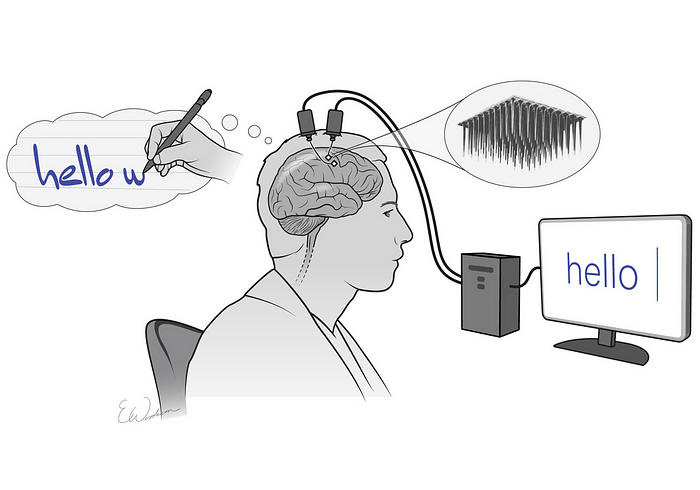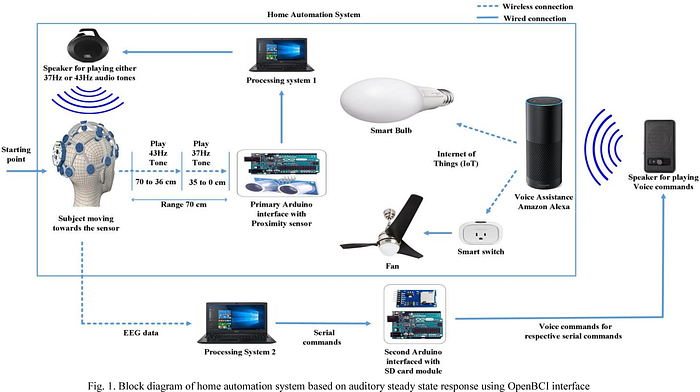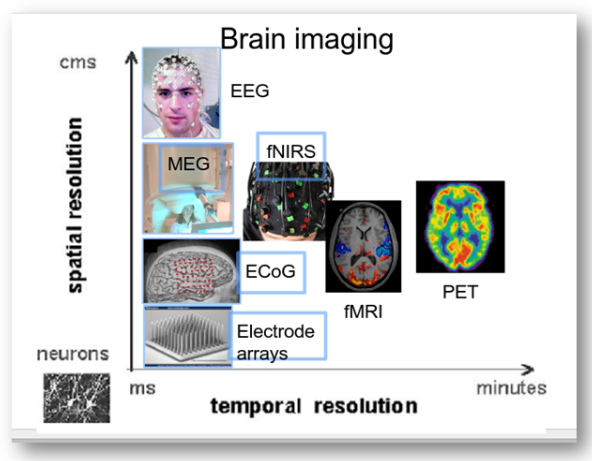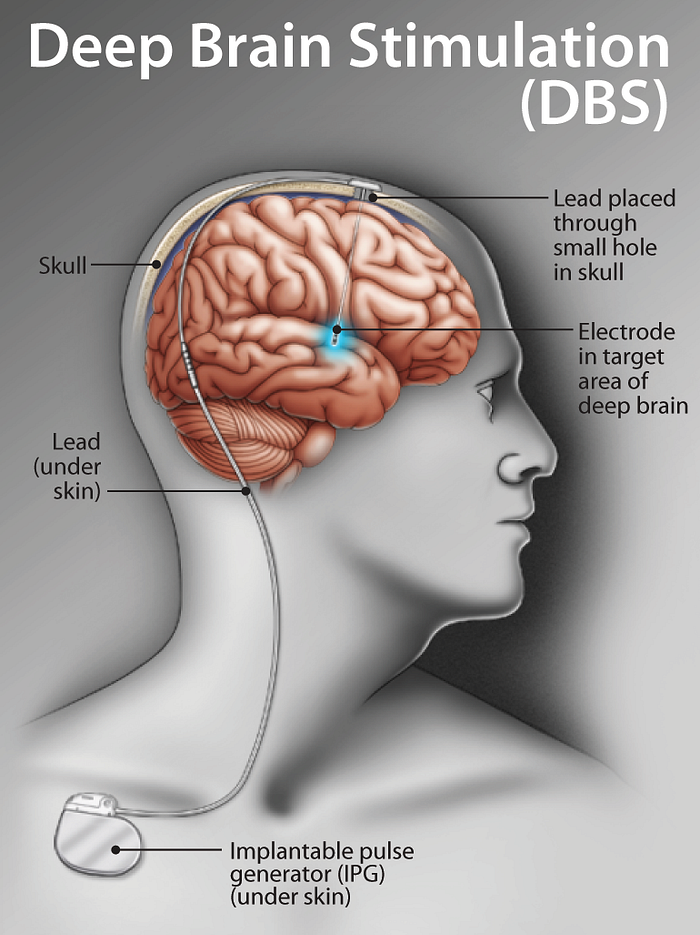BCIs: Bridging the Gap Between Our Minds and Our Potential.

Humans have been creating technology ever since we can remember. In result, we’re always trying to make this technology better, easier to use, and more efficient. Accessibility has always been a vital part when it came to developing tech. Steve Jobs and Tim Cook both valued accessibility to it’s 100% when it came to developing the iPhone 📱. Now, however, there are much bigger, better ways to increase accessibility and efficiency. We have increased the range of who we can help through the development of one type of technology. Brain computer interfaces 🧠.
- A brain computer interface is a way for your brain to communicate with other devices, such as computers or robots (these are the most common ones used today for testing and in medical clinics). They come in various types. There are Invasive BCIs, Semi-Invasive BCIs, and Non-Invasive BCIs. All of these types of BCIs have their own imaging techniques.
Potential of the Technology
First, lets talk about how BCIs can help us improve our lives. Let’s start with the priority use case as of right now. This is to help disabled people access technology just as neurotypical people would. A great example of this would be Dennis Degray.
“You are holding in your hand the very first text message ever sent from the neurons of one mind to the mobile device of another. U just made history.”
That was a text message that Dennis Degray sent to his friend, using a brain-computer interface. You see, Dennis Degray got paralyzed from the collarbones down due to a fall. He was able to send this text message because he had two chips of silicon placed onto his motor cortex, which is the part of the brain that controls movement. These two tiny pieces of technology record the neural activity and translates them into external action, therefore, allowing Dennis to think of whatever he wanted to do, and having that be done. For example, if Dennis thought about moving a mouse while being connected to a computer, the cursor on the computer screen would move 🖥️.
Dennis Degray moving a cursor on a screen with the power of his mind
Obviously, there are a lot of use cases in the medical industry for this type of technology. From paralyzed people, to injured seniors, clinics can benefit from this technology 🏥. We’ll dive into the medical side of things more when I talk about the different imaging techniques, but for now, lets talk about the potential in average, daily life.
Lets use our imagination and see how far this technology can take us…
Okay, imagine the following:
You wake up and magically fine-tune your surroundings to be adjusted just as you like it 😊.
When it’s time to work, instead of using a keyboard and mouse, you magically communicate with your computer and tell it what you want it to do. This allows for not only much more efficiency as you can write full emails within a second, but also frees up time to spend with your family and have fun. (P.S. Imagine coupling this with AI!)
Later on, you decide to have some free time and watch a movie. You magically immerse yourself into the movie to make it seem like you’re actually in it, with experiences feeling real. How real? Well, that’s up to you.
When you leave the house, you magically activate the security system in your home, without touching a button.
You come back feeling a bit stressed. Your brain magically notices this and gives you on the spot breathing exercises, allowing you to destress and relax.
Your son/daughter is now on their laptop, doing an educational program that magically helps them in their weakest areas, challenges their strong areas more, and adapts to their learning style.
Finally, you go to bed and your brain magically relaxes you so you can get a great good night’s rest 🛏️.
Now, replace all the ‘magically’ with ‘with the help of brain-computer interfaces’. Wow. Right now, this may seem a little far-fetched🤔. Kind of like something from a high-tech Hollywood movie. However, once this technology is perfected, this can very well become the norm.

Okay, we’ve talked a lot about it’s potential. Now let’s get into the theory of it and how exactly it works, along with all the different techniques that are used.
Types Of BCIs
There are mainly three types of brain computer interfaces. Non-invasive, semi invasive, invasive. All of these different types of brain computer interfaces use different kinds of imaging techniques.
Non Invasive:
Non-Invasive Brain Computer Interfaces are designed so that they don’t have to go through your brain and no surgery is generally required. Due to this, it is very accessible. Some public Non-Invasive BCIs available include the muse headsets, and Neorhythm(Omnipemf). Here are some of the methods for non-invasive BCIs:
Electroencephalography (EEG): EEGs are one of the most common and widely accessible brain computer interfaces. Basically, you put a headset that contains electrodes onto your head. This allows the BCI to read your brain signals and neural activity, and, for example, digitize it and send it to an external device such as a computer 🖥️.
Functional Magnetic Resonance Imaging (fMRI): fMRIs are used a lot in the medical industry. Although they aren’t really headsets that you can put on your head like EEGs, they have pretty good spatial imaging to really show doctors how a brain is working. They essentially allow you to see the blood flow of the brain without doing surgery. However, they don’t have great temporal resolution, meaning that the data collection is slowed down. This method is primarily used for neuroimaging.
Functional Near-Infrared Spectroscopy (fNIRS): This method indicates the changes in blood oxygen levels in the brain, giving you an indirect measure of brain activity. This allows for doctors to see the neurofeedback, to understand the condition of someone’s brain better 🧠.

Semi-invasive:
Semi-invasive Brain-Computer Interfaces are exactly as the name suggests. They are sort of invasive. As in, they aren’t exactly placed inside the brain, however, they are usually placed on the exposed surface of the brain.
- Electrocorticography (ECoG): Electrodes are placed on the surface of the brain and are generally used to measure electrical activity from the cerebral cortex. They can be used to decode movements, speech, and even vision due to the fact that it is a stronger signal than an EEG for example.
Invasive:
Invasive Brain-Computer Interfaces, are, you guessed it, invasive. They are placed right inside of your brain. As you can guess, they give you the strongest brain signals, but they are also a little dangerous and are more prone to problems than other types of BCIs.
- Deep Brain Stimulation (DBS): This method is essentially putting a device into your brain and allows for electrical impulses to be delivered to different parts of the brain. This is used in the medical industry all the time as it can help treat Parkinson’s Disease and reduce tremors. This is possible as it has the potential to communicate to the motor cortex, so it can restrict and un-restrict movement.

Final Thoughts
Overall, BCIs have a lot of potential in changing our world. For now, it is mostly used in the medical industry to help the disabled. But, what happens when it crosses this medical border🏥? Imagine a world with everyone wearing a headset/chip on/in their head 🌎. Would corporations try to take advantage of this? Would we start getting advertisements in our head? Would there be a premium plan to bypass this 💵? Would this eliminate the need to even step outside of our homes besides when we need to get groceries? Will our thoughts be changed? Would countries and big corporations take advantage of this? Will our privacy be breached causing cybersecurity to be in high demand? Although this seems like a future very far away, it’s not impossible. It’s amazing to think about the good things about BCIs, but it’s very important to be aware of the possible downsides.
I believe there are many good uses for this technology and it should be harnessed as a way for us to interact with the things we make at a higher level. For example, imagine being able to talk to your computer with keyboards and mice😲! Our minds are so complex and technology is the most complex thing we’ve created. Let’s bridge two complex things to make things that can benefit us and unlock the full potential of our technology.
TL;DR
Introduction: Humans are always striving for acceleration and efficiency. We can harness this through BCIs. A BCI is a way for our brain to communicate with external devices.
How Can BCIs help?: From depression to helping paralyzed people, BCIs have the potential to be very prominent in the medical industry. The interesting part is when they merge into everyday life.
How do they work?: Three types of BCIs: Non-Invasive, Semi-Invasive, and Invasive. Each have their methods/techniques for imaging and their own purpose. Most common one that is available to the public are EEG headsets.
Concerns: Not only ethical concerns, but also the room for businesses and governments taking advantage of this as well as data breaches in the future. Would definitely call for advanced cybersecurity.
Final Thoughts: Overall, lots of potential for this type of technology. Can help bridge the potential gap between our minds and the technology we create.
A Video:
In case the article was too much, here is a short video that gives you an idea of what BCIs are all about:
It’s one of the videos that sparked my interest in BCIs. It 5 minutes long, so it’s not too long.
Hey! My name is AJ and I am a 14 year old who is interested in technology, specifically new, upcoming, and innovative tech! I like to learn and explore said technologies.
Contact me here: abhijay.work5002@gmail.com
Citations:
“Brain-Computer Interface User Types 90 Characters per Minute with Mind.” The Scientist Magazine®, www.the-scientist.com/news-opinion/brain-computer-interface-user-types-90-characters-per-minute-with-mind-68762. Accessed 20 Oct. 2023.
“Intro to Brain Computer Interface.” NeurotechEDU, learn.neurotechedu.com/introtobci/#invasive. Accessed 25 Oct. 2023.
NP;, Miller KJ;Hermes D;Staff. “The Current State of Electrocorticography-Based Brain-Computer Interfaces.” Neurosurgical Focus, U.S. National Library of Medicine, pubmed.ncbi.nlm.nih.gov/32610290/#:~:text=Electrocorticography%20(ECoG)%20electrodes%20provide%20a,movements%2C%20vision%2C%20and%20speech. Accessed 25 Oct. 2023.